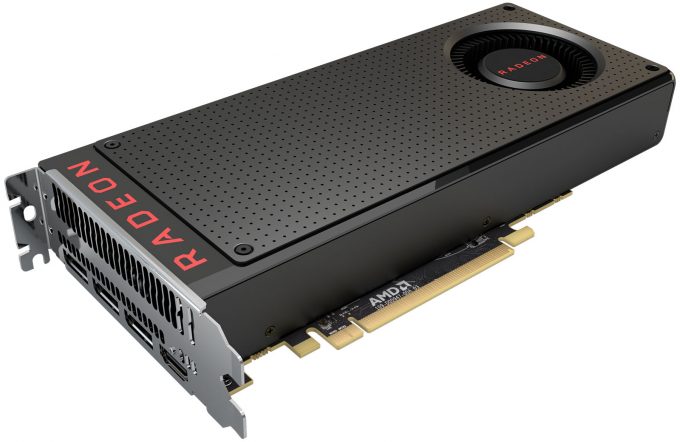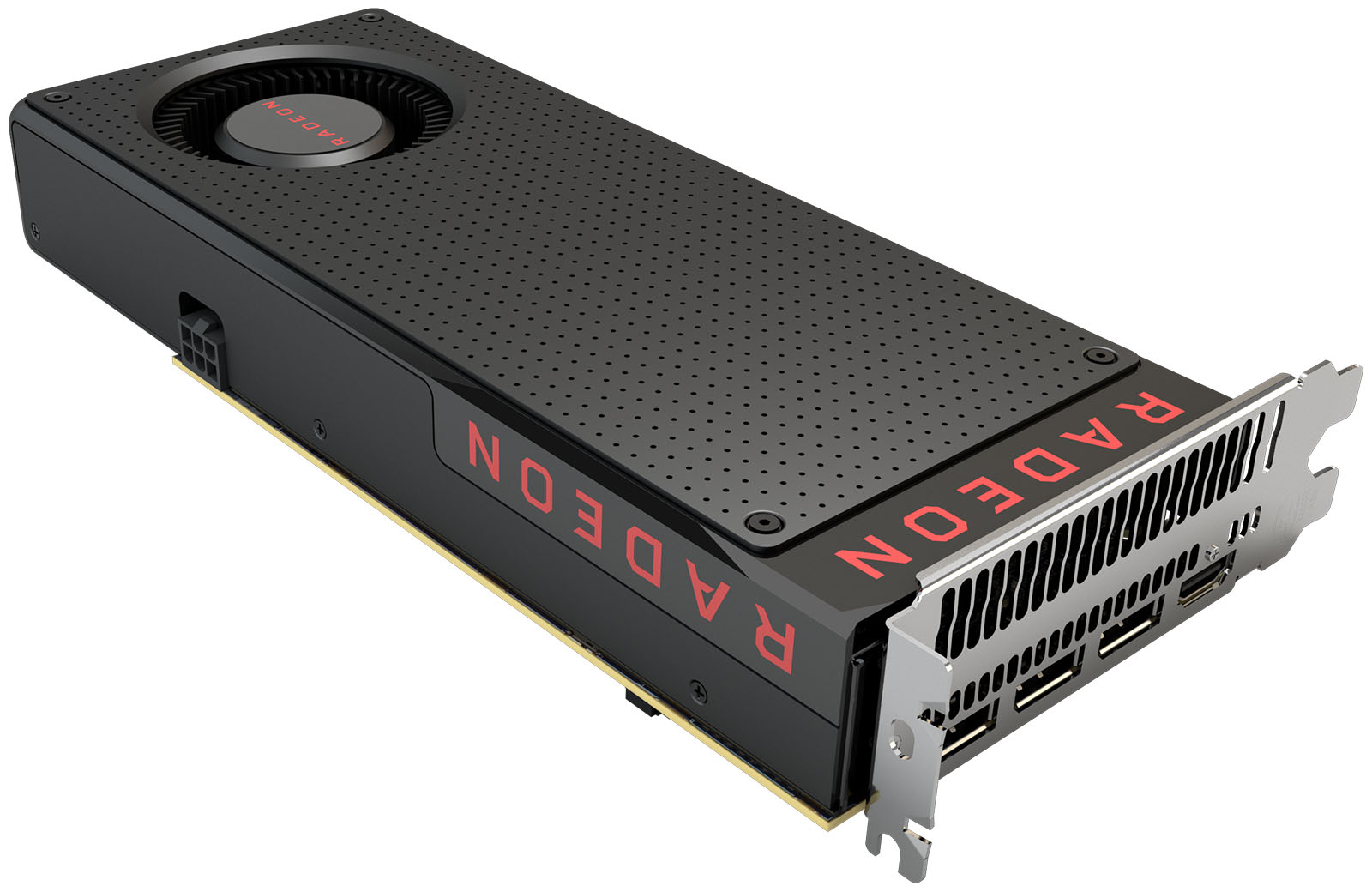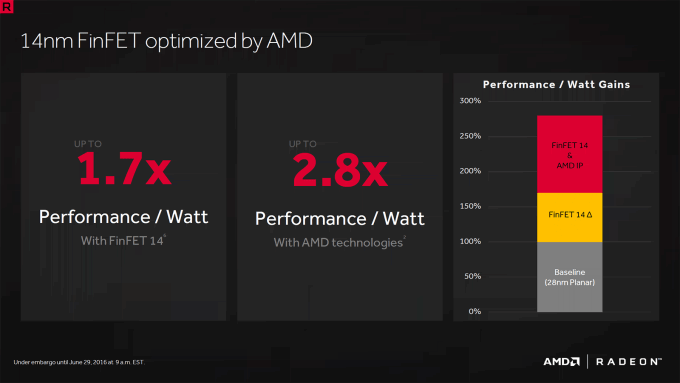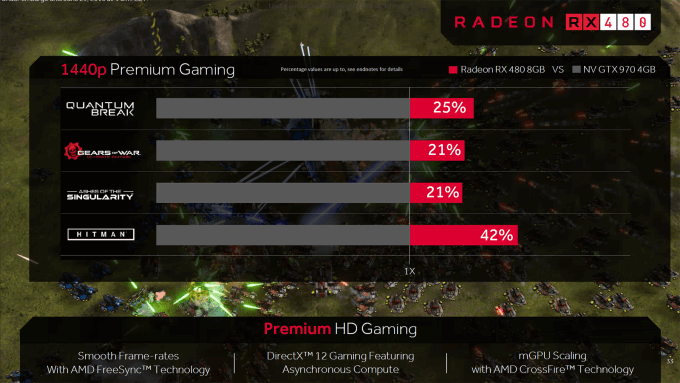- Qualcomm Launches Snapdragon 4 Gen 2 Mobile Platform
- AMD Launches Ryzen PRO 7000 Series Mobile & Desktop Platform
- Intel Launches Sleek Single-Slot Arc Pro A60 Workstation Graphics Card
- NVIDIA Announces Latest Ada Lovelace Additions: GeForce RTX 4060 Ti & RTX 4060
- Maxon Redshift With AMD Radeon GPU Rendering Support Now Available
AMD’s Polaris Has Landed: A Look At The $200 Radeon RX 480

The moment many PC gaming enthusiasts have been waiting for is here: AMD’s first Polaris based GPU has arrived. Much of what makes the Radeon RX 480 an alluring card isn’t a secret, as AMD itself has been talking about it quite extensively, so let’s just get right down to business: what can AMD’s latest $200 Radeon muster?
Page 1 – Introduction, About The RX 480 & Testing Notes
Whoa, has that time finally arrived? Indeed it has! AMD’s much-anticipated Radeon RX 480 – its first Polaris card – has landed. This should of course come as no surprise unless you’re without a calendar (somehow), as AMD has made no secret about when the card would be released. What the company has kept mum on, though, is performance. Don’t worry – we have that for you.
For a couple of reasons (none of which have AMD to blame), I had very limited time to churn this review out. That being the case, it’s not going to be as in-depth as I’d like, but it will contain everything important you need to know.
First things first: the price. AMD’s 4GB Radeon RX 480 will retail for $199, while the 8GB model will tack on a $40 premium. We’re not sure at this point if the memory on both cards is clocked the same (we couldn’t get an answer in time for publishing), as the RX 480’s 8000MHz is definitely a premium clock, but once we know for sure, we’ll update this.
AMD’s Radeon RX 480 features a familiar reference cooler, which looks quite sharp overall. It’s clean, and gives the impression that it’s rugged (I still wouldn’t recommend throwing it). At the back of the card are three DisplayPorts and a lone HDMI. Partner cards might offer a DVI port, but in the worst case, an adapter could be used instead (we’d anticipate that some AIBs will include one in the box).
We don’t know all of the specs of AMD’s upcoming Polaris cards, RX 470 and RX 460, but given that most GPU launches don’t start off with a bang and then dissipate immediately, we’re sure to learn a lot more about those models soon.
What we can reveal now, though, is that the RX 470 is designed to power full-featured 1080p gaming, while the RX 460 is for ‘eSports’. That’s a broad description, but we read it to mean that the most popular MOBAs out there, and games like CS: GO, will run smooth as butter on this Radeon. And, given its name, and the fact that the RX 480 is $200, we can expect some attractive pricing on that card, too.
Alright, back to the RX 480.
| AMD Radeon Series | Cores | Core MHz | Memory | Mem MHz | Mem Bus | TDP |
| Radeon RX 480 | 2304 | 1266 | ≤8192MB | 8000 | 256-bit | 150W |
| Radeon RX 470* | 2048 | 1206 | ≤8192MB | 7000 | 256-bit | 110W |
| Radeon RX 460* | 1280 | 1000 | 4096MB | ? | 128-bit | 75W |
| Radeon Pro Duo | 4096*2 | 1000 | 4096MB*2 | 1000 | 4096-bit*2 | 350W |
| Radeon R9 Fury X | 4096 | 1050 | 4096MB | 1000 | 4096-bit | 275W |
| Radeon R9 Fury | 3584 | 1000 | 4096MB | 1000 | 4096-bit | 275W |
| Radeon R9 Nano | 4096 | 1000 | 4096MB | 1000 | 4096-bit | 175W |
| Radeon R9 390X | 2816 | 1050 | 8192MB | 6000 | 512-bit | 275W |
| Radeon R9 390 | 2560 | 1000 | 8192MB | 6000 | 512-bit | 275W |
| Radeon R9 380X | 2048 | 970 | 4096MB | 5700 | 256-bit | 190W |
| Radeon R9 380 | 1792 | 970 | 4096MB | 5700 | 256-bit | 190W |
| *Rumored specifications | ||||||
AMD says that its RX 480 has “up to” 5.8 TFLOPs of computing power, which puts it in the same position as the R9 390X. Unfortunately, we never received that card to review, and thus can’t use it for comparison. In fact, we simply don’t have a “perfect” card to compare it to in general, but that could be soon remedied if the rumormill is to be believed, as NVIDIA’s GeForce GTX 1060 is allegedly en route.
In the slider above we can see a few more angles of the card (again, due to time, I opted to use stock photos). One thing of interest can be seen on the card’s top: there’s just a single 6-pin power connector. If that doesn’t seem impressive, consider the fact that this card will go neck-and-neck with the R9 390X, a card which had both an 8- and 6-pin connector.
Oh – and the 390X was a 275W card. RX 480 is 150W. AMD’s done well, here.
A huge reason for the power drop is the move to the FinFET process, one shared by the green team with Pascal. That’s not the only reason, though, and it’s not even a “major” one. AMD has said that with its move to FinFET, the performance/watt increased 1.7x. However, combined with other architecture updates and all-around polishing, the full performance/watt gain (over the previous generation) is 2.8x.
It doesn’t really need to be said, but that’s damned impressive.
While we’re going to get into performance in a moment, I thought I’d include a slide here that illustrates what kind of gains AMD expects gamers to see over NVIDIA’s GeForce GTX 970. That’s one GPU I regret not being able to test in time for this article, so this might help clear up that particular battle.
Alright, enough said. It’s time to get into the meat of the review, and tackle the one thing people want to know: performance. Without further ado:
Testing Notes
When we need to build a test PC for performance testing, “no bottleneck” is the name of the game. While we admit that few of our readers are going to be equipped with an Intel 8-core processor clocked to 4GHz, we opt for such a build to make sure our GPU testing is as apples-to-apples as possible, with as little variation as possible. Ultimately, the only thing that matters here is the performance of the GPUs, so the more we can rule out a bottleneck, the better.
That all said, our test PC:
| Graphics Card Test System | |
| Processors | Intel Core i7-5960X (8-core) @ 4.0GHz |
| Motherboard | ASUS X99 DELUXE |
| Memory | Kingston HyperX Beast 32GB (4x8GB) – DDR4-2133 11-12-11 |
| Graphics | AMD Radeon R9 Nano 4GB – Catalyst 16.5.3 AMD Radeon RX 480 8GB – Catalyst 16.6.2 Beta NVIDIA GeForce GTX 980 4GB – GeForce 365.22 NVIDIA GeForce GTX TITAN X 12GB – GeForce 365.22 NVIDIA GeForce GTX 1070 8GB – GeForce 368.19 (Beta) NVIDIA GeForce GTX 1080 8GB – GeForce 368.25 |
| Audio | Onboard |
| Storage | Kingston SSDNow V310 1TB SSD |
| Power Supply | Cooler Master Silent Pro Hybrid 1300W |
| Chassis | Cooler Master Storm Trooper Full-Tower |
| Cooling | Thermaltake WATER3.0 Extreme Liquid Cooler |
| Displays | Acer Predator X34 34″ Ultra-wide Acer XB280HK 28″ 4K G-SYNC ASUS MG279Q 27″ 1440p FreeSync |
| Et cetera | Windows 10 Pro (10586) 64-bit |
Framerate information for all tests – with the exception of certain time demos and DirectX 12 tests – are recorded with the help of Fraps. For tests where Fraps use is not ideal, I use the game’s built-in test (the only option for DX12 titles right now). In the past, I’ve tweaked the Windows OS as much as possible to rule out test variations, but over time, such optimizations have proven fruitless. As a result, the Windows 10 installation I use is about as stock as possible, with minor modifications to suit personal preferences.
In all, I use 8 different games for regular game testing, and 2 for DirectX 12 testing. That’s in addition to the use of three synthetic benchmarks. Because some games are sponsored, the list below helps oust potential bias in our testing.
(AMD) – Ashes of the Singularity (DirectX 12)
(AMD) – Battlefield 4
(AMD) – Crysis 3
(AMD) – Hitman (DirectX 12)
(NVIDIA) – Metro: Last Light Redux
(NVIDIA) – Rise Of The Tomb Raider (incl. DirectX 12)
(NVIDIA) – The Witcher 3: Wild Hunt
(Neutral) – DOOM
(Neutral) – Grand Theft Auto V
(Neutral) – Total War: ATTILA
If you’re interested in benchmarking your own configuration to compare to our results, you can download this file (5MB) and make sure you’re using the exact same graphics settings. I’ll lightly explain how I benchmark each test before I get into each game’s performance results.
Because the RX 480 is targeted at 1080p/1440p gamers, that’s what I chose to test with. Even the top-end GPUs available right now are not what most people would consider “ideal” for 4K or even 3440×1440 gaming, and this $200 offering isn’t changing that. While ultrawide testing was not included here, the RX 480 would be suitable for 2560×1080, which renders less pixels than 1440p (2.76 megapixel vs. 3.69 megapixel).
With that all said, let’s dive right into our test results.
Support our efforts! With ad revenue at an all-time low for written websites, we're relying more than ever on reader support to help us continue putting so much effort into this type of content. You can support us by becoming a Patron, or by using our Amazon shopping affiliate links listed through our articles. Thanks for your support!














